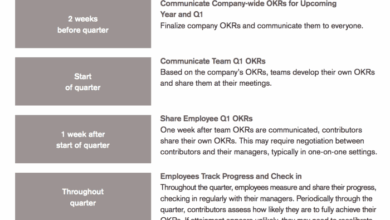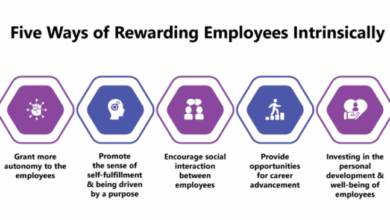
OKRs and performance evaluation are crucial for any successful business. This guide delves into the intricacies of defining, setting, and linking Objectives and Key Results (OKRs) to effective performance evaluations, ensuring alignment between individual and organizational goals. The process of aligning individual contributions with overall business objectives is at the heart of this discussion.
From establishing clear and measurable OKRs to choosing the right performance evaluation methods, this comprehensive overview covers all aspects of this critical business function. It provides practical examples, methodologies, and tools to help you implement and optimize your OKR and performance evaluation strategy. We’ll explore how to address performance gaps and continuously refine your processes for maximum effectiveness.
Defining OKRs and Performance Evaluation
OKRs, or Objectives and Key Results, have become a popular framework for setting ambitious goals and tracking progress in organizations. They provide a structured approach to defining desired outcomes and measuring the steps taken to achieve them. Performance evaluations, on the other hand, are crucial for assessing employee contributions and aligning individual efforts with organizational objectives. This section explores the relationship between these two essential components of a high-performing organization.Performance evaluations are vital in any business setting.
They offer a structured mechanism for assessing employee performance, identifying areas for improvement, and providing constructive feedback. By providing a transparent system for measuring and rewarding achievement, evaluations facilitate a culture of accountability and continuous development.
Defining Objectives and Key Results (OKRs)
OKRs are a goal-setting framework that focuses on ambitious, qualitative objectives, with measurable key results. Objectives are broad statements of what a team or individual aims to accomplish, while key results are specific, quantifiable metrics used to track progress toward the objective. A well-defined OKR system establishes clear expectations, motivates teams to strive for excellence, and provides a transparent method for measuring progress.
Purpose of Performance Evaluations
Performance evaluations are designed to assess an employee’s contributions to the organization. They provide a structured way to measure performance against established standards, offer feedback, and identify areas where employees can improve their skills and knowledge. Regular evaluations facilitate a continuous feedback loop, allowing for adjustments and improvement in individual and team performance.
Relationship Between OKRs and Performance Evaluations
OKRs and performance evaluations are intrinsically linked. OKRs establish the strategic goals, while performance evaluations ensure that individual and team efforts contribute to achieving those goals. Performance evaluations are used to assess how well employees are performing against their OKRs and how they can be further supported or coached to reach their objectives. By aligning individual performance with organizational objectives, a well-integrated system of OKRs and performance evaluations creates a strong foundation for success.
Key Differences Between OKRs and Traditional Performance Reviews
| Feature | OKRs | Traditional Performance Reviews |
|---|---|---|
| Focus | Strategic alignment and progress towards ambitious objectives | Assessing past performance against pre-defined metrics |
| Timeframe | Typically quarterly or annually, focusing on longer-term goals | Usually annual, focusing on a specific period |
| Metrics | Specific, measurable, achievable, relevant, and time-bound (SMART) key results | Often subjective assessments of performance |
| Scope | Organizational-level and team-level goals | Individual employee performance |
| Purpose | Drive strategic initiatives and measure progress | Provide feedback, identify strengths and weaknesses, and guide development |
Traditional performance reviews often focus on evaluating past performance, while OKRs are more forward-looking, aiming to drive progress towards future goals. This table highlights the crucial distinctions between these two systems.
Setting Effective OKRs

OKRs, or Objectives and Key Results, are powerful tools for defining and tracking progress toward strategic goals. Effective OKRs motivate teams and individuals, ensuring alignment with overarching business objectives. They translate abstract aspirations into concrete, measurable steps, enabling consistent progress and accountability.Clear and well-defined OKRs are critical for success. They provide a roadmap, ensuring everyone is working towards the same objectives.
This clarity minimizes ambiguity and fosters a shared understanding of priorities. This focused effort maximizes productivity and ensures that the organization stays on track.
Best Practices for Defining Clear and Measurable OKRs, Okrs and performance evaluation
Well-defined OKRs are characterized by specificity, measurability, and alignment. They should be ambitious yet achievable, motivating individuals and teams to strive for excellence. Aligning OKRs with overall business objectives ensures that individual efforts contribute to the collective success.
- Specificity: OKRs should be unambiguous and clearly articulate the desired outcome. Avoid vague language. For example, instead of “Increase brand awareness,” a more specific objective might be “Increase social media engagement by 20% in Q3.”
- Measurability: Key Results must be quantifiable. Use metrics that allow for precise tracking of progress. For example, instead of “Improve customer satisfaction,” a measurable key result could be “Increase customer satisfaction scores by 15% based on Net Promoter Score (NPS).”
- Time-Bound: OKRs should have a defined timeframe for completion. This creates urgency and helps in tracking progress. For instance, “Increase sales by 10% in Q4” sets a clear timeframe for the objective.
- Ambition: While achievable, OKRs should still challenge teams to push boundaries and aim for significant progress. Overly easy objectives won’t inspire the same level of motivation.
- Collaboration: OKRs should be developed collaboratively, involving key stakeholders. This ensures buy-in and alignment. Involving all relevant teams promotes shared understanding and ownership.
Examples of Well-Defined OKRs
Effective OKRs provide a clear path for progress, ensuring accountability and driving desired results. Here are examples for various business functions:
- Marketing: Objective: Increase website traffic by 15%. Key Results: Achieve 10,000 unique visitors per week; Generate 500 qualified leads through targeted campaigns.
- Sales: Objective: Close 20 major deals. Key Results: Achieve 10 qualified sales meetings per week; Close 10 deals worth over $10,000 each.
- Product Development: Objective: Launch a new mobile app. Key Results: Complete the app development within 12 weeks; Achieve a 4.5-star rating on app stores within 2 months of launch.
Alignment of Individual OKRs with Business Objectives
Aligning individual OKRs with overall business objectives is paramount. This ensures that everyone is working towards the same goals. This cohesive effort results in a powerful synergy that drives the company forward.Individual OKRs should be derived from and support overarching business objectives. This connection ensures that everyone is working towards a shared vision and that the contributions of each individual contribute to the overall success of the organization.
OKR Methodologies Comparison
Different organizations may utilize various OKR methodologies. Understanding these differences helps organizations tailor their approaches to best suit their needs.
| Methodology | Key Characteristics |
|---|---|
| Traditional OKR | Focuses on objectives and key results; emphasizes alignment and progress tracking. |
| Agile OKR | Integrates OKRs with agile development methodologies; promotes iterative progress and adaptability. |
| OKR with Dashboards | Uses data visualization tools to track progress and identify areas needing attention; provides a clear view of overall progress. |
Linking OKRs to Performance Evaluation
OKRs, or Objectives and Key Results, are powerful tools for setting and achieving ambitious goals. However, their effectiveness hinges on a clear connection to performance evaluation. This crucial link ensures that individual and team contributions are directly aligned with organizational objectives, enabling a more transparent and impactful performance management system. By defining clear performance metrics derived from OKRs, progress towards those objectives becomes quantifiable and easily tracked.A robust connection between OKRs and performance evaluation allows for a more objective assessment of employee performance.
This, in turn, leads to a more equitable and fair performance management process. Instead of relying on subjective opinions, evaluation is based on demonstrable results and measurable progress toward predetermined objectives.
Defining Performance Metrics from OKRs
Connecting OKRs to performance metrics requires careful consideration of the key results. Each key result should have measurable metrics that indicate progress. These metrics should be specific, measurable, achievable, relevant, and time-bound (SMART). This ensures that progress towards the OKR can be objectively tracked and evaluated.For example, if an OKR is to “Increase website traffic by 20%,” a relevant performance metric could be “Number of unique website visitors.” This metric is directly tied to the key result and can be easily tracked.
Similarly, if the key result is to “Improve customer satisfaction scores,” the metric might be “Average customer satisfaction rating on a 5-point scale.”
Measuring Progress Towards OKRs During Evaluation
Regular check-ins and progress reports are essential to monitor progress toward OKRs during the evaluation period. These reports should provide a clear picture of the current status and any roadblocks encountered. This data will be crucial during the evaluation process. Data points collected throughout the period will inform the final assessment.Regular progress reports can take many forms, including weekly updates, progress dashboards, or even short meetings.
The frequency and format should be tailored to the specific OKRs and the team’s needs. Consistent reporting allows for proactive identification of potential issues and timely adjustments to strategies. By monitoring progress on a regular basis, the team can stay on track and address any challenges that may arise.
Steps for Linking OKRs to Performance Evaluations
This table Artikels the crucial steps for effectively linking OKRs to performance evaluations.
| Step | Description |
|---|---|
| 1. Identify OKRs | Clearly define the objectives and key results for the evaluation period. This involves specifying the goals and the measurable outcomes. |
| 2. Define Performance Metrics | For each key result, establish specific, measurable, achievable, relevant, and time-bound (SMART) metrics. These metrics should directly reflect progress towards the key result. |
| 3. Establish Evaluation Criteria | Develop clear criteria for evaluating performance based on the defined metrics. This could involve targets, thresholds, or specific achievements. |
| 4. Track Progress | Implement a system for regularly tracking progress towards the OKRs. This could include progress reports, meetings, or other data collection methods. |
| 5. Assess Performance | Evaluate performance against the established metrics and criteria. Provide constructive feedback and identify areas for improvement. |
| 6. Review and Adjust | Regularly review the OKRs and performance evaluation process to ensure alignment with organizational goals and to make necessary adjustments. |
Performance Evaluation Methods
Performance evaluation is a crucial aspect of any successful organization. It provides a framework for assessing individual and team contributions, identifying areas for improvement, and driving continuous growth. Choosing the right methods is paramount to ensuring fairness, accuracy, and alignment with organizational goals. This section delves into various evaluation approaches, highlighting their advantages and drawbacks.
Performance Evaluation Methodologies
Different methodologies offer unique perspectives on employee performance. Selecting the right method depends heavily on the specific role, team dynamics, and the desired outcomes. A comprehensive approach often incorporates a blend of multiple methods for a holistic evaluation.
- 360-Degree Feedback: This method gathers input from various stakeholders, including supervisors, peers, subordinates, and even clients. It provides a multifaceted view of an employee’s strengths and weaknesses, offering a broader perspective than a single manager’s assessment. However, it can be time-consuming and require careful implementation to avoid bias or inconsistencies in the feedback collected. For example, in a sales team, 360-degree feedback could include customer feedback on the sales representative’s communication and product knowledge, alongside feedback from the manager and colleagues on teamwork and time management.
- Self-Assessments: Employees assess their own performance against predefined criteria. This approach fosters self-awareness and encourages reflection. It can be a valuable tool for identifying areas where the employee feels they excelled and areas needing improvement. However, self-assessments can be prone to bias and may not accurately reflect the impact of the employee’s work on others or the organization.
In project management roles, self-assessments can be particularly helpful in evaluating the ability to meet deadlines and effectively manage resources, but the manager’s input is essential to gain a balanced perspective.
- Peer Reviews: Colleagues evaluate each other’s performance, fostering a sense of accountability and mutual support. This method can provide insights into teamwork, collaboration, and communication skills. However, potential conflicts of interest or biases among peers need to be carefully managed. In a marketing team, peer reviews can be effective in assessing the quality of collaboration during campaigns and the effectiveness of communication strategies.
OKRs and performance evaluation are crucial for any organization, especially when dealing with complex projects. Think about how IBM’s ambitious plan to create a supercomputer for analyzing telescope data, like this one , requires meticulous planning and rigorous measurement of success. Ultimately, effective performance evaluation systems are key to ensuring these large-scale endeavors align with overall organizational objectives.
- Supervisory Assessments: This method focuses on the direct manager’s evaluation of an employee’s performance. It leverages the manager’s direct observation of the employee’s work and contributions to the team. It’s a direct and efficient method for assessing the employee’s progress and aligning their performance with the team’s objectives. A manager’s perspective in a software development team is crucial to evaluating code quality, adherence to coding standards, and the ability to work effectively within a team.
Selecting the Right Method
The optimal performance evaluation method varies significantly based on the specific role and team dynamics. Considerations include the complexity of the tasks, the level of interaction with others, and the desired outcomes.
- Project-Based Roles: For project-based roles, a combination of supervisory assessments and peer reviews might be most effective. This allows for direct evaluation of project deliverables and collaboration within the team. The use of a project rubric, focusing on timeliness, quality, and team collaboration, will greatly enhance the evaluation process.
- Customer-Facing Roles: In customer-facing roles, 360-degree feedback, incorporating customer input, is highly beneficial. This ensures a holistic understanding of the employee’s performance, considering both internal and external perspectives. The feedback should be structured around specific customer interactions, communication, and problem-solving skills.
Using a Rubric for OKR Evaluation
A performance rubric provides a structured framework for evaluating performance against specific OKRs. It defines clear criteria for each level of performance, enabling consistent and fair evaluations.
| OKR | Criteria | Excellent | Good | Needs Improvement |
|---|---|---|---|---|
| Increase Website Traffic by 20% | Website traffic increase | +25% or more | +15% – +24% | <15% |
| Improve Customer Satisfaction Score by 10% | Customer satisfaction score | +15% or more | +5% – +14% | <5% |
A well-designed rubric ensures that the evaluation process is objective and transparent, allowing employees to understand the expectations and receive constructive feedback.
Addressing Performance Gaps: Okrs And Performance Evaluation

Identifying and rectifying performance gaps is crucial for continuous improvement and achieving organizational objectives. A proactive approach to addressing these gaps, utilizing constructive feedback and actionable strategies, empowers employees to enhance their performance and contribute more effectively to the team’s overall success. This process also fosters a culture of continuous learning and development within the organization.Addressing performance gaps isn’t about fault-finding; it’s about providing employees with the tools and support they need to excel.
Understanding the root causes of performance discrepancies is paramount to developing effective solutions that promote growth and improvement.
Strategies for Addressing Performance Gaps
Performance gaps often stem from various factors, including skill deficiencies, lack of clarity on expectations, or insufficient resources. Developing tailored strategies that address these underlying causes is essential for effective improvement. These strategies should be collaborative and focus on supporting employees to overcome the obstacles hindering their performance.
- Skill Development Programs: Providing training and development opportunities directly targets skill gaps. This might include workshops, online courses, mentorship programs, or shadowing experienced colleagues. For example, if an employee consistently struggles with project management software, a training session on the software can significantly improve their performance in that area.
- Clarifying Expectations and Roles: Ambiguity about roles and responsibilities can lead to subpar performance. Ensure that expectations are clearly defined, documented, and communicated effectively to each employee. This includes outlining performance metrics, deadlines, and deliverables. A clear understanding of their role will lead to more effective execution.
- Providing Resources and Support: Adequate resources, including necessary tools, equipment, and access to information, are critical for optimal performance. Ensure employees have the resources required to meet their objectives. This could include access to relevant software, technical support, or even additional team members.
- Implementing Regular Feedback Mechanisms: Establishing a system for regular feedback, both formal and informal, is crucial for identifying issues early on. Constructive feedback provides employees with valuable insights into their strengths and areas for improvement, enabling them to make necessary adjustments to their approach.
Utilizing Feedback to Improve Future Performance
Feedback is a powerful tool for driving growth and development. It provides insights into areas for improvement and helps employees understand how their actions impact others. Implementing a feedback loop that allows for two-way communication between management and employees is crucial for this process.
- Actively Seeking Feedback: Encourage employees to seek feedback from colleagues, supervisors, and clients to gain a broader perspective on their performance. Encourage them to identify areas where they can enhance their approach and improve their effectiveness.
- Providing Constructive Feedback: Focus on specific behaviors and actions, rather than general statements. Provide clear and actionable suggestions for improvement, coupled with examples of how the desired behavior can be demonstrated.
- Creating a Safe Feedback Culture: Foster an environment where employees feel comfortable sharing both positive and negative feedback. This involves creating a safe space where individuals feel comfortable giving and receiving feedback without fear of reprisal.
Actionable Steps to Help Employees Achieve OKRs
Effective actionable steps should align with the identified performance gaps and the employee’s individual needs.
- Identify the Root Cause: Carefully analyze the specific reasons behind performance gaps. Don’t jump to solutions without understanding the underlying issues.
- Develop a Personalized Improvement Plan: Create a tailored plan that Artikels specific steps, timelines, and resources needed to address the gaps. The plan should be measurable and attainable.
- Provide Ongoing Support and Monitoring: Regular check-ins and progress updates are crucial for maintaining momentum. Provide support and encouragement, while holding the employee accountable for their progress.
Potential Areas for Improvement
The following table Artikels potential areas for improvement based on performance evaluation results. It’s crucial to note that this table is a template and needs to be adapted to reflect the specific needs of each employee.
| Employee | Area of Improvement | Specific Actions | Timeline | Metrics for Success |
|---|---|---|---|---|
| John Smith | Project Management Skills | Complete project management training course | 2 months | Demonstrate improved project planning and execution |
| Emily Brown | Communication Skills | Attend communication workshops and practice active listening | 3 months | Receive positive feedback on communication clarity and effectiveness |
| David Lee | Time Management | Develop a detailed time management strategy and utilize time management tools | 4 weeks | Demonstrate improved task completion and adherence to deadlines |
Tools and Technologies for OKRs and Performance Evaluation
Effective OKR management and performance evaluation hinges on the right tools. Choosing the right platform streamlines the process, improves transparency, and ultimately boosts team performance. These tools go beyond simple task management; they provide a structured framework for tracking progress, analyzing results, and fostering continuous improvement.
Popular Tools for Managing OKRs
A variety of tools cater to different needs and organizational structures. From simple spreadsheets to sophisticated software platforms, the selection depends on factors like team size, complexity of OKRs, and desired level of integration with other systems. Choosing a suitable platform ensures that data is readily accessible and analysis is straightforward.
- Google Workspace (formerly G Suite): Google Workspace offers a suite of tools including Google Sheets, Docs, and Calendar, enabling basic OKR management. Team collaboration and shared access are straightforward features, making it suitable for smaller teams. However, its limitations include a lack of dedicated OKR tracking features and advanced reporting.
- Asana: Asana is a popular project management tool that can be used to manage OKRs. Its features include task assignment, progress tracking, and collaboration tools. Asana can work well for teams that are already using it for project management, but may lack dedicated OKR reporting and analysis.
- monday.com: monday.com is a flexible platform allowing customization for different workflows, including OKR management. Its drag-and-drop interface and extensive features make it adaptable to various team structures and needs. However, its comprehensive nature may come with a steeper learning curve.
- OKR.com: Dedicated OKR platforms like OKR.com provide specialized features for defining, tracking, and reporting on OKRs. They often offer advanced visualization tools, allowing teams to gain insights into progress and identify areas needing attention. These tools are ideal for organizations with a significant emphasis on OKR management.
Comparative Analysis of Platforms
Different platforms cater to varying requirements. Comparing platforms based on features, pricing, and scalability is crucial. Consider factors like the size of your team, the complexity of your OKRs, and your budget when making your decision.
| Tool | Key Features | Pricing | Scalability |
|---|---|---|---|
| Google Workspace | Basic collaboration, spreadsheet management | Free/Paid (based on plan) | Limited, suitable for smaller teams |
| Asana | Project management features, task assignment, progress tracking | Free/Paid (based on plan) | Scalable with paid plans |
| monday.com | Customizable workflows, extensive features, flexible dashboards | Paid (based on plan) | High scalability, suitable for larger organizations |
| OKR.com | Dedicated OKR features, advanced reporting, visualization | Paid (based on plan) | Scalable, tailored for OKR management |
Features and Functionalities of Tools
A comprehensive platform for OKR management should ideally encompass several key functionalities. These include defining and assigning OKRs, tracking progress, reporting on results, and enabling collaboration.
OKRs and performance evaluation are crucial for any company’s success, but often require a nuanced approach. Google, for example, has a unique perspective on this, as evidenced by their innovative strategies, like the ones highlighted in their recent article on google provides a clearer view of glass. Ultimately, a robust performance evaluation system, tailored to individual roles and company goals, is essential for effective OKR implementation.
- Defining and assigning OKRs: The platform should facilitate the clear articulation of Objectives and Key Results, with mechanisms for assigning ownership and responsibilities.
- Progress tracking: Tools should allow for regular monitoring of progress toward achieving Key Results. Visual representations of progress are highly beneficial.
- Reporting on results: The ability to generate reports on OKR performance is essential for evaluating progress and identifying areas for improvement. Different reporting formats are helpful for various purposes.
- Collaboration features: Facilitating team collaboration is critical for effective OKR implementation. Platforms should support discussions, comments, and shared access to information.
Communication and Feedback
Effective OKR (Objectives and Key Results) implementation relies heavily on clear communication and consistent feedback. Open dialogue ensures everyone understands their role in achieving the objectives and fosters a collaborative environment. This allows for adjustments to strategies and resources as needed, ultimately increasing the likelihood of success.Open communication isn’t just about sharing information; it’s about fostering a culture of transparency and trust.
Regular feedback loops, both formal and informal, help individuals understand their performance in relation to objectives and identify areas for improvement. This process not only benefits individual performance but also contributes to the overall team and organizational success.
Importance of Clear Communication
Clear communication regarding OKRs and performance expectations sets a shared understanding of goals and individual responsibilities. This clarity minimizes ambiguity and fosters accountability. When everyone is on the same page, progress towards objectives is smoother, and potential roadblocks can be identified and addressed proactively. Ambiguous goals can lead to misalignment and decreased productivity.
Providing Constructive Feedback
Constructive feedback during performance evaluations is crucial for growth and development. Focus on specific behaviors and outcomes rather than general statements. Provide examples to illustrate your points, linking them directly to the OKRs and expected performance. Use “I” statements to express your observations without placing blame. For example, instead of saying “You didn’t meet the sales target,” say “I noticed the sales figures for Q3 were below the target.
OKRs and performance evaluations are crucial for any successful team. Think of them as the roadmap to achieving goals. But, just like a faster hard drive can boost productivity, innovative technologies like helium filled hard drives lift performance significantly. Helium filled hard drives lift performance by reducing friction and improving data transfer speeds. Ultimately, these advancements translate into more efficient processes and ultimately better performance evaluation results.
So, are you using the right tools to maximize your team’s potential?
Could we discuss the challenges you faced in closing deals in this quarter?”
Role of Regular Check-ins and Progress Updates
Regular check-ins and progress updates are vital for maintaining momentum and addressing any potential issues early on. These informal discussions provide opportunities to address concerns, offer support, and make necessary adjustments to strategies. These check-ins, whether weekly or bi-weekly, can be informal conversations or scheduled meetings, depending on the team structure and preferences. By keeping the lines of communication open, the team can proactively identify and address roadblocks before they significantly impact progress.
A team that regularly checks in and updates progress is more likely to achieve their OKRs.
Structure of a Constructive Feedback Session
| Stage | Description |
|---|---|
| Introduction (5 minutes) | Set the context for the feedback session. Briefly review the OKRs and the employee’s role within them. Establish a positive and supportive tone. |
| Review of Performance (10 minutes) | Focus on specific examples and quantifiable results. Use data and metrics to illustrate progress against the OKRs. Highlight both strengths and areas for improvement. |
| Discussion and Explanation (10 minutes) | Open a dialogue to understand the context behind the performance. Actively listen to the employee’s perspective. Explore potential contributing factors and challenges. |
| Action Planning (5 minutes) | Collaboratively develop actionable steps for improvement. Define specific, measurable, achievable, relevant, and time-bound (SMART) goals. Set clear expectations and deadlines for implementation. |
| Follow-up (5 minutes) | Schedule a follow-up meeting to review progress and address any further questions or concerns. Reinforce the commitment to ongoing support and development. |
Adapting OKRs and Evaluations for Different Roles
OKRs and performance evaluations are crucial for aligning individual and team efforts with organizational goals. However, a one-size-fits-all approach rarely works. Different roles, departments, and even team sizes require tailored OKRs and evaluation methods to be effective. This section dives into adapting these processes for a variety of situations.Effective performance management adapts to the specific needs and responsibilities of each role, fostering a more engaging and productive work environment.
This dynamic approach ensures that individual contributions are accurately assessed and recognized, ultimately driving overall organizational success.
Leadership OKRs and Evaluations
Leadership roles demand a focus on strategic direction and team performance. Leadership OKRs should emphasize broader organizational impact, such as revenue growth, market share gains, or new product development. Evaluation criteria should include strategic vision, ability to inspire and motivate teams, decision-making quality, and the achievement of pre-defined strategic goals. For example, a VP of Sales might have OKRs focused on increasing sales revenue by a specific percentage and achieving specific market share targets.
Their performance evaluation could assess their ability to lead successful sales strategies, develop high-performing sales teams, and consistently meet revenue targets.
Individual Contributor OKRs and Evaluations
Individual contributors, on the other hand, typically focus on specific tasks and projects. Their OKRs should align with the broader team and organizational objectives but be more granular and measurable. Evaluation criteria should center around the quality, efficiency, and timeliness of work. A software engineer, for example, might have OKRs focused on completing a specific number of features, improving code quality metrics, or resolving bugs within a given timeframe.
Their evaluation might consider factors like code quality, problem-solving skills, adherence to deadlines, and collaborative efforts.
Adapting for Diverse Teams and Sizes
Different team sizes and organizational structures require adjustments to OKR structures. Smaller teams often benefit from more collaborative OKRs, while larger teams may need more segmented OKRs, each focused on a particular department or project. This approach ensures that each team member understands how their individual contributions directly support the broader organizational goals.
Example OKR Structures
| Team Size | OKR Structure |
|---|---|
| Small (2-5 members) | Collaborative OKRs focusing on shared goals. Evaluation emphasizing teamwork and individual contributions to the team’s success. |
| Medium (6-15 members) | Segmented OKRs with clear individual and team objectives. Evaluation considering both individual performance and team collaboration. |
| Large (16+ members) | Hierarchical OKRs with clear reporting lines. Evaluation focusing on individual contributions within a specific team or department and how those contributions impact the overall organization. |
Challenges and Considerations
Adapting processes for diverse teams presents several challenges. Ensuring alignment between individual and team objectives is crucial. Defining clear expectations, providing appropriate resources, and establishing fair evaluation criteria are key factors in addressing these challenges. Consideration of cultural nuances and individual learning styles within the team is also essential for successful implementation. Also, transparent communication and feedback mechanisms are paramount.
Continuous Improvement and Refinement
OKRs and performance evaluations are not static documents. A dynamic, adaptable system is crucial for sustained success. Regular review and adjustment are essential to ensure alignment with evolving business needs and to maximize the effectiveness of the framework. This ongoing process of refinement keeps the system relevant and drives continuous improvement.Regular review of OKRs and performance evaluations is not just a good practice; it’s vital for success.
It allows organizations to stay agile, adapt to changes in the market, and maintain a strong focus on strategic goals. By fostering a culture of continuous improvement, organizations can ensure their strategies remain effective and relevant.
Importance of Regular Review and Adjustment
Regular reviews ensure that OKRs remain aligned with the overall strategic direction of the organization. Changes in market conditions, competitive landscapes, or internal priorities can render previously established objectives obsolete. By frequently assessing OKRs, organizations can proactively address these changes and adjust their goals accordingly. This proactive approach helps maintain focus and avoids wasted effort on outdated objectives.
Methods for Gathering Feedback
Gathering feedback is crucial for improving the effectiveness of the OKR and performance evaluation system. A variety of methods can be used to solicit input, including surveys, focus groups, and one-on-one discussions. Surveys can provide quantitative data on employee perceptions, while focus groups offer valuable qualitative insights. Regular check-ins and feedback sessions with team members and managers are vital for ongoing dialogue and improvement.
Adapting to Changing Business Needs and Priorities
The business environment is inherently dynamic. Market shifts, technological advancements, and economic fluctuations necessitate adjustments to strategic priorities. Adapting the OKR and performance evaluation frameworks to these changes ensures that the organization remains responsive and competitive. This adaptability allows the organization to maintain its strategic focus and continue pursuing its mission.
Periodic Review and Update Method
A structured approach to periodic review and update is essential. A quarterly or biannual review cycle is recommended. This cadence allows for adjustments based on performance data, feedback, and changes in business priorities. The process should include:
- Performance Data Analysis: Review key performance indicators (KPIs) and assess progress against OKRs. Identify areas where performance is exceeding expectations and areas where adjustments are needed.
- Feedback Integration: Collect feedback from employees, managers, and stakeholders. Use this feedback to identify strengths and weaknesses of the current framework and identify opportunities for improvement.
- Strategic Alignment Review: Ensure that OKRs remain aligned with the latest strategic goals and priorities. If necessary, revise objectives and key results to reflect new directions. The entire process should align with the organization’s vision and mission statements.
- Framework Refinement: Based on the analysis, feedback, and strategic alignment review, refine the OKR and performance evaluation frameworks to improve clarity, effectiveness, and practicality. Make adjustments to metrics, timelines, and overall structure to reflect learnings and enhance outcomes.
Example of a Review Cycle
Imagine a company focusing on expanding its e-commerce platform. A quarterly review reveals that customer acquisition is lagging behind projections. Feedback indicates that the marketing campaigns are not resonating with the target audience. The OKRs are updated to reflect a revised marketing strategy, and the performance evaluation criteria are adjusted to incorporate new metrics related to customer engagement and conversion rates.
Closure
In conclusion, understanding and effectively implementing OKRs and performance evaluations is vital for driving performance and achieving organizational goals. This detailed exploration of the topic highlights the importance of aligning individual contributions with overall business objectives, measuring progress effectively, and providing constructive feedback. By adopting the strategies and tools presented, businesses can optimize their performance management systems and cultivate a culture of continuous improvement.






